Human Resource Management Case Study: 'No Name' and Diversity Issues
VerifiedAdded on 2021/05/31
|9
|2820
|44
Case Study
AI Summary
This case study analyzes the diversity management practices at 'No Name', an aircraft manufacturing company, highlighting challenges related to employee diversity, organizational culture, performance management, and training and development. The analysis reveals a lack of effective HR strategies to handle diversity issues, including the integration of diverse teams and the inclusion of employees with disabilities. The case study emphasizes the importance of a strong organizational culture that promotes collaboration, communication, and equal treatment among all employees, regardless of their background or role. It also examines the role of performance management, training, and development in enhancing employee performance and fostering a more inclusive workplace. The study recommends a comprehensive approach to diversity management, including formal HR policies, training programs, and team-building activities, to improve employee morale, productivity, and overall organizational success. The case study also stresses the importance of leadership in driving cultural change and promoting social action within the organization.
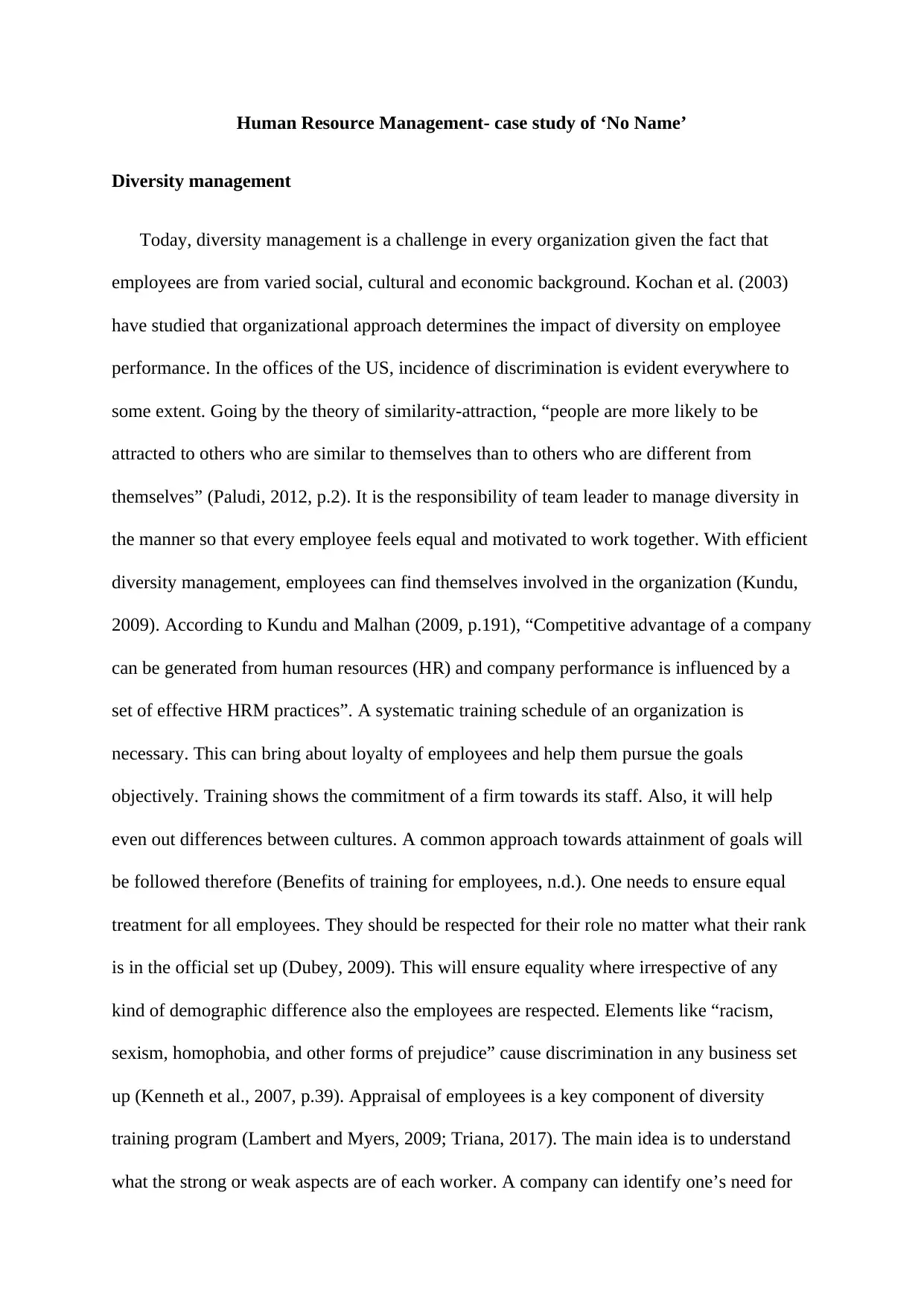
Human Resource Management- case study of ‘No Name’
Diversity management
Today, diversity management is a challenge in every organization given the fact that
employees are from varied social, cultural and economic background. Kochan et al. (2003)
have studied that organizational approach determines the impact of diversity on employee
performance. In the offices of the US, incidence of discrimination is evident everywhere to
some extent. Going by the theory of similarity-attraction, “people are more likely to be
attracted to others who are similar to themselves than to others who are different from
themselves” (Paludi, 2012, p.2). It is the responsibility of team leader to manage diversity in
the manner so that every employee feels equal and motivated to work together. With efficient
diversity management, employees can find themselves involved in the organization (Kundu,
2009). According to Kundu and Malhan (2009, p.191), “Competitive advantage of a company
can be generated from human resources (HR) and company performance is influenced by a
set of effective HRM practices”. A systematic training schedule of an organization is
necessary. This can bring about loyalty of employees and help them pursue the goals
objectively. Training shows the commitment of a firm towards its staff. Also, it will help
even out differences between cultures. A common approach towards attainment of goals will
be followed therefore (Benefits of training for employees, n.d.). One needs to ensure equal
treatment for all employees. They should be respected for their role no matter what their rank
is in the official set up (Dubey, 2009). This will ensure equality where irrespective of any
kind of demographic difference also the employees are respected. Elements like “racism,
sexism, homophobia, and other forms of prejudice” cause discrimination in any business set
up (Kenneth et al., 2007, p.39). Appraisal of employees is a key component of diversity
training program (Lambert and Myers, 2009; Triana, 2017). The main idea is to understand
what the strong or weak aspects are of each worker. A company can identify one’s need for
Diversity management
Today, diversity management is a challenge in every organization given the fact that
employees are from varied social, cultural and economic background. Kochan et al. (2003)
have studied that organizational approach determines the impact of diversity on employee
performance. In the offices of the US, incidence of discrimination is evident everywhere to
some extent. Going by the theory of similarity-attraction, “people are more likely to be
attracted to others who are similar to themselves than to others who are different from
themselves” (Paludi, 2012, p.2). It is the responsibility of team leader to manage diversity in
the manner so that every employee feels equal and motivated to work together. With efficient
diversity management, employees can find themselves involved in the organization (Kundu,
2009). According to Kundu and Malhan (2009, p.191), “Competitive advantage of a company
can be generated from human resources (HR) and company performance is influenced by a
set of effective HRM practices”. A systematic training schedule of an organization is
necessary. This can bring about loyalty of employees and help them pursue the goals
objectively. Training shows the commitment of a firm towards its staff. Also, it will help
even out differences between cultures. A common approach towards attainment of goals will
be followed therefore (Benefits of training for employees, n.d.). One needs to ensure equal
treatment for all employees. They should be respected for their role no matter what their rank
is in the official set up (Dubey, 2009). This will ensure equality where irrespective of any
kind of demographic difference also the employees are respected. Elements like “racism,
sexism, homophobia, and other forms of prejudice” cause discrimination in any business set
up (Kenneth et al., 2007, p.39). Appraisal of employees is a key component of diversity
training program (Lambert and Myers, 2009; Triana, 2017). The main idea is to understand
what the strong or weak aspects are of each worker. A company can identify one’s need for
Paraphrase This Document
Need a fresh take? Get an instant paraphrase of this document with our AI Paraphraser

training by implementing schemes of incentives and rewards (Banu & Umamaheswari,
2009). With a proper appraisal system in place, one can understand the level of performance
and integrity of an employee base characterized by divergence of cultures (Jabeen, 2011).
Team collaboration in the workplace is important and helps reduce diversities in cultures.
Ways of communication differs between cultures. For instance, in western culture, ways of
communicating are direct or straightforward. Unlike this, for other cultures, communication
could be indicative, i.e. certain gestures could decide what message is being communicated.
When a Japanese says yes it often indicates he is listening but for an American manager it
might seem like he is answering in affirmative to something (Brett et al., 2006).
In order to resolve such problems, the team leader should initiate and bring about
communication between team members such that they may agree with each other on certain
issues (Sweeny & McFarlin, 2012). Studies have shown that a formal HR policy is imperative
in order to boost morale in employees as non-managerial staff feel the need of some kind of
guidance even if management is adept at handling diverse staff needs (Cooke & Saini, 2010).
Today, the problem lies not only in the diverse workforce that exists in every organization but
a lack of strategy that enables employees from all cultures to come together and work in
harmony (Cox, 1991; Fernandez, 1991). A crisis can occur when manager is restricted by his
prejudices and therefore fails to make optimum utilization of his workforce (Barak, 2013,
p.2). In ‘No Name’, there is a serious lack of HR strategy to handle diversity issues as a result
of which different employees are not willing to work in coordination. The issue of physical
disability also needs to be taken into consideration since the company’s subsidiaries in China
is losing talent by dismissing disabled people. The purpose of the strategy at No Name is to
provide an inclusive environment for the workers. This can help every employee attain his
full potential. This will give birth to a cultural context that can benefit everyone. (Rosado,
2006).
2009). With a proper appraisal system in place, one can understand the level of performance
and integrity of an employee base characterized by divergence of cultures (Jabeen, 2011).
Team collaboration in the workplace is important and helps reduce diversities in cultures.
Ways of communication differs between cultures. For instance, in western culture, ways of
communicating are direct or straightforward. Unlike this, for other cultures, communication
could be indicative, i.e. certain gestures could decide what message is being communicated.
When a Japanese says yes it often indicates he is listening but for an American manager it
might seem like he is answering in affirmative to something (Brett et al., 2006).
In order to resolve such problems, the team leader should initiate and bring about
communication between team members such that they may agree with each other on certain
issues (Sweeny & McFarlin, 2012). Studies have shown that a formal HR policy is imperative
in order to boost morale in employees as non-managerial staff feel the need of some kind of
guidance even if management is adept at handling diverse staff needs (Cooke & Saini, 2010).
Today, the problem lies not only in the diverse workforce that exists in every organization but
a lack of strategy that enables employees from all cultures to come together and work in
harmony (Cox, 1991; Fernandez, 1991). A crisis can occur when manager is restricted by his
prejudices and therefore fails to make optimum utilization of his workforce (Barak, 2013,
p.2). In ‘No Name’, there is a serious lack of HR strategy to handle diversity issues as a result
of which different employees are not willing to work in coordination. The issue of physical
disability also needs to be taken into consideration since the company’s subsidiaries in China
is losing talent by dismissing disabled people. The purpose of the strategy at No Name is to
provide an inclusive environment for the workers. This can help every employee attain his
full potential. This will give birth to a cultural context that can benefit everyone. (Rosado,
2006).
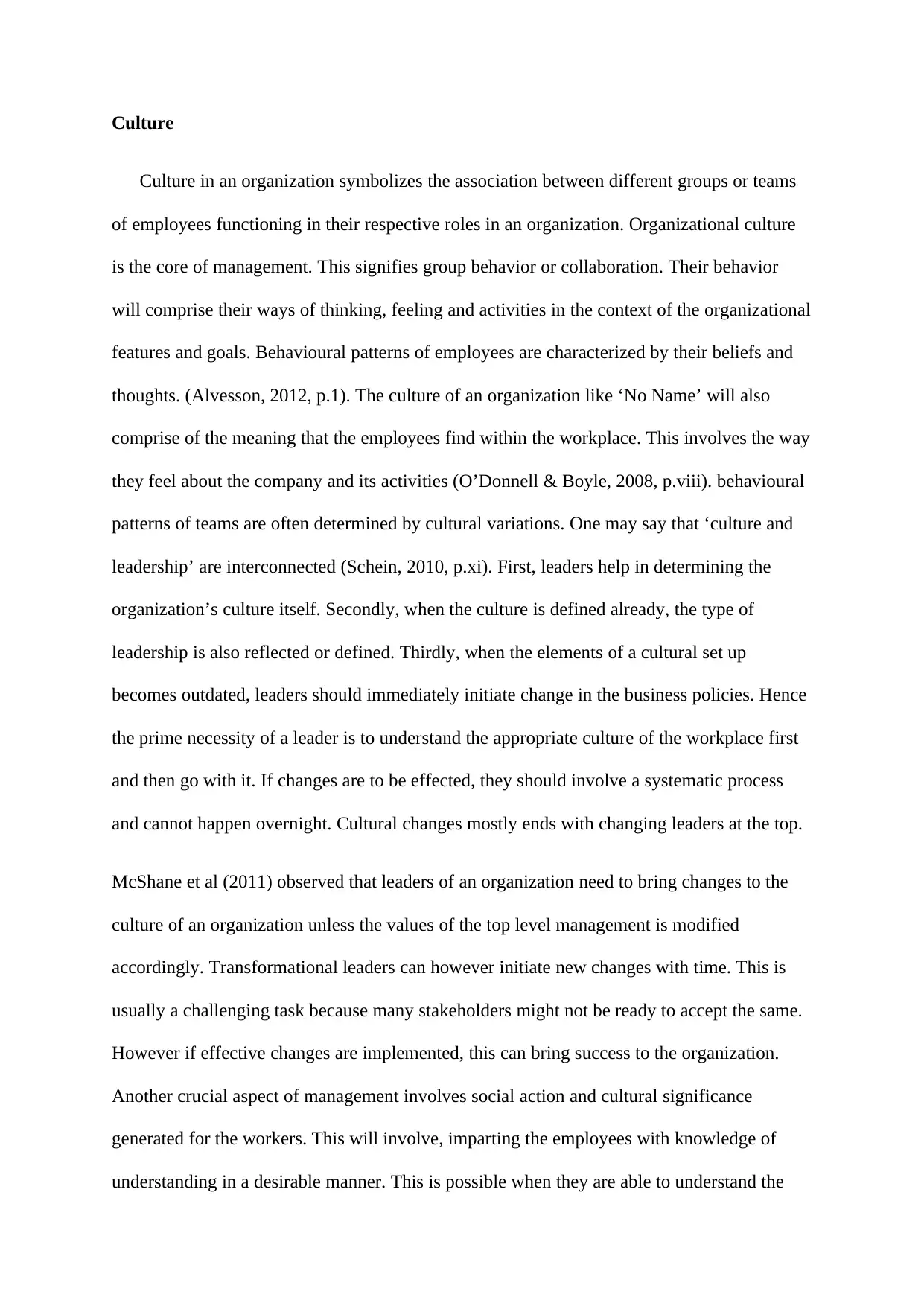
Culture
Culture in an organization symbolizes the association between different groups or teams
of employees functioning in their respective roles in an organization. Organizational culture
is the core of management. This signifies group behavior or collaboration. Their behavior
will comprise their ways of thinking, feeling and activities in the context of the organizational
features and goals. Behavioural patterns of employees are characterized by their beliefs and
thoughts. (Alvesson, 2012, p.1). The culture of an organization like ‘No Name’ will also
comprise of the meaning that the employees find within the workplace. This involves the way
they feel about the company and its activities (O’Donnell & Boyle, 2008, p.viii). behavioural
patterns of teams are often determined by cultural variations. One may say that ‘culture and
leadership’ are interconnected (Schein, 2010, p.xi). First, leaders help in determining the
organization’s culture itself. Secondly, when the culture is defined already, the type of
leadership is also reflected or defined. Thirdly, when the elements of a cultural set up
becomes outdated, leaders should immediately initiate change in the business policies. Hence
the prime necessity of a leader is to understand the appropriate culture of the workplace first
and then go with it. If changes are to be effected, they should involve a systematic process
and cannot happen overnight. Cultural changes mostly ends with changing leaders at the top.
McShane et al (2011) observed that leaders of an organization need to bring changes to the
culture of an organization unless the values of the top level management is modified
accordingly. Transformational leaders can however initiate new changes with time. This is
usually a challenging task because many stakeholders might not be ready to accept the same.
However if effective changes are implemented, this can bring success to the organization.
Another crucial aspect of management involves social action and cultural significance
generated for the workers. This will involve, imparting the employees with knowledge of
understanding in a desirable manner. This is possible when they are able to understand the
Culture in an organization symbolizes the association between different groups or teams
of employees functioning in their respective roles in an organization. Organizational culture
is the core of management. This signifies group behavior or collaboration. Their behavior
will comprise their ways of thinking, feeling and activities in the context of the organizational
features and goals. Behavioural patterns of employees are characterized by their beliefs and
thoughts. (Alvesson, 2012, p.1). The culture of an organization like ‘No Name’ will also
comprise of the meaning that the employees find within the workplace. This involves the way
they feel about the company and its activities (O’Donnell & Boyle, 2008, p.viii). behavioural
patterns of teams are often determined by cultural variations. One may say that ‘culture and
leadership’ are interconnected (Schein, 2010, p.xi). First, leaders help in determining the
organization’s culture itself. Secondly, when the culture is defined already, the type of
leadership is also reflected or defined. Thirdly, when the elements of a cultural set up
becomes outdated, leaders should immediately initiate change in the business policies. Hence
the prime necessity of a leader is to understand the appropriate culture of the workplace first
and then go with it. If changes are to be effected, they should involve a systematic process
and cannot happen overnight. Cultural changes mostly ends with changing leaders at the top.
McShane et al (2011) observed that leaders of an organization need to bring changes to the
culture of an organization unless the values of the top level management is modified
accordingly. Transformational leaders can however initiate new changes with time. This is
usually a challenging task because many stakeholders might not be ready to accept the same.
However if effective changes are implemented, this can bring success to the organization.
Another crucial aspect of management involves social action and cultural significance
generated for the workers. This will involve, imparting the employees with knowledge of
understanding in a desirable manner. This is possible when they are able to understand the
⊘ This is a preview!⊘
Do you want full access?
Subscribe today to unlock all pages.

Trusted by 1+ million students worldwide
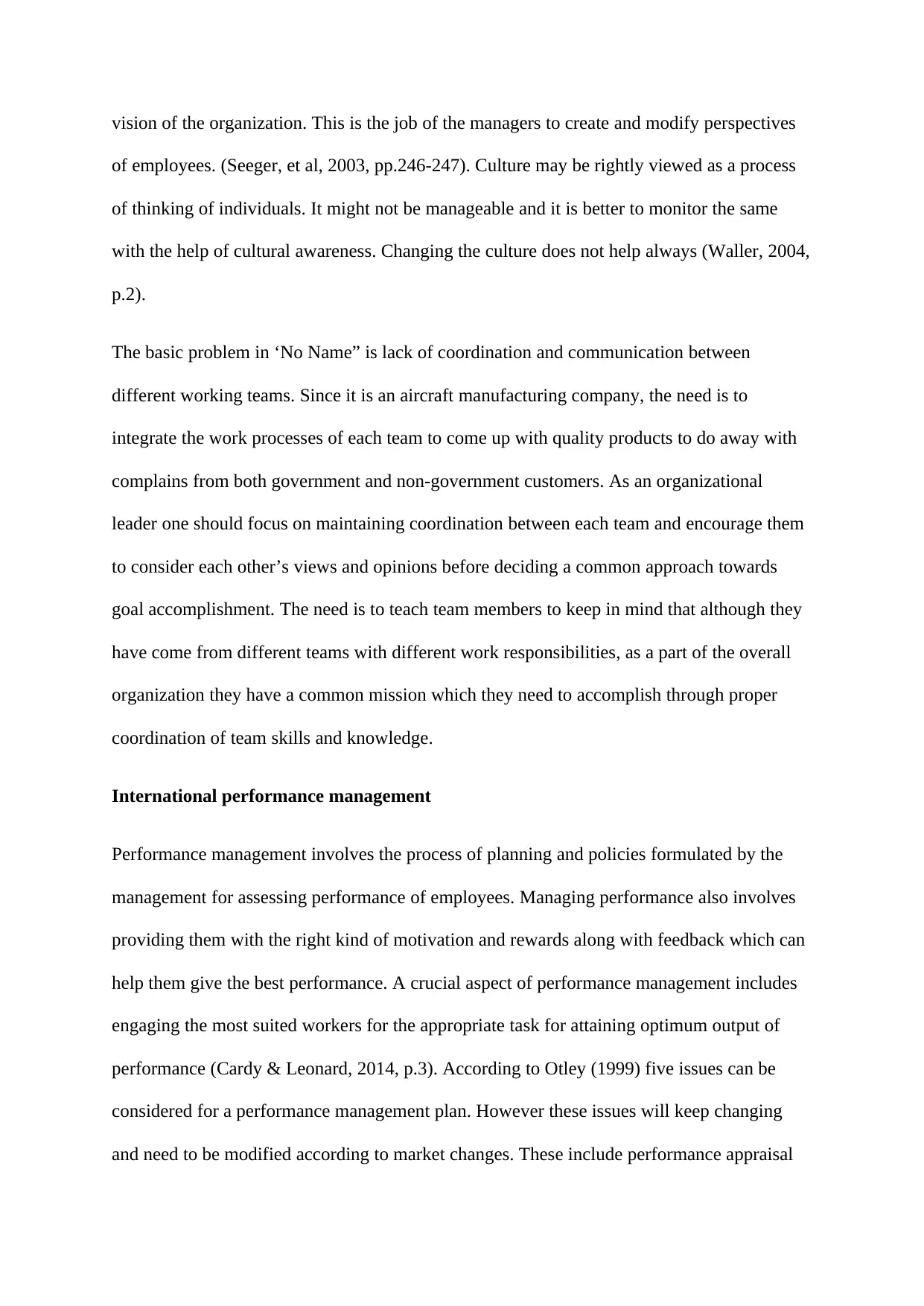
vision of the organization. This is the job of the managers to create and modify perspectives
of employees. (Seeger, et al, 2003, pp.246-247). Culture may be rightly viewed as a process
of thinking of individuals. It might not be manageable and it is better to monitor the same
with the help of cultural awareness. Changing the culture does not help always (Waller, 2004,
p.2).
The basic problem in ‘No Name” is lack of coordination and communication between
different working teams. Since it is an aircraft manufacturing company, the need is to
integrate the work processes of each team to come up with quality products to do away with
complains from both government and non-government customers. As an organizational
leader one should focus on maintaining coordination between each team and encourage them
to consider each other’s views and opinions before deciding a common approach towards
goal accomplishment. The need is to teach team members to keep in mind that although they
have come from different teams with different work responsibilities, as a part of the overall
organization they have a common mission which they need to accomplish through proper
coordination of team skills and knowledge.
International performance management
Performance management involves the process of planning and policies formulated by the
management for assessing performance of employees. Managing performance also involves
providing them with the right kind of motivation and rewards along with feedback which can
help them give the best performance. A crucial aspect of performance management includes
engaging the most suited workers for the appropriate task for attaining optimum output of
performance (Cardy & Leonard, 2014, p.3). According to Otley (1999) five issues can be
considered for a performance management plan. However these issues will keep changing
and need to be modified according to market changes. These include performance appraisal
of employees. (Seeger, et al, 2003, pp.246-247). Culture may be rightly viewed as a process
of thinking of individuals. It might not be manageable and it is better to monitor the same
with the help of cultural awareness. Changing the culture does not help always (Waller, 2004,
p.2).
The basic problem in ‘No Name” is lack of coordination and communication between
different working teams. Since it is an aircraft manufacturing company, the need is to
integrate the work processes of each team to come up with quality products to do away with
complains from both government and non-government customers. As an organizational
leader one should focus on maintaining coordination between each team and encourage them
to consider each other’s views and opinions before deciding a common approach towards
goal accomplishment. The need is to teach team members to keep in mind that although they
have come from different teams with different work responsibilities, as a part of the overall
organization they have a common mission which they need to accomplish through proper
coordination of team skills and knowledge.
International performance management
Performance management involves the process of planning and policies formulated by the
management for assessing performance of employees. Managing performance also involves
providing them with the right kind of motivation and rewards along with feedback which can
help them give the best performance. A crucial aspect of performance management includes
engaging the most suited workers for the appropriate task for attaining optimum output of
performance (Cardy & Leonard, 2014, p.3). According to Otley (1999) five issues can be
considered for a performance management plan. However these issues will keep changing
and need to be modified according to market changes. These include performance appraisal
Paraphrase This Document
Need a fresh take? Get an instant paraphrase of this document with our AI Paraphraser
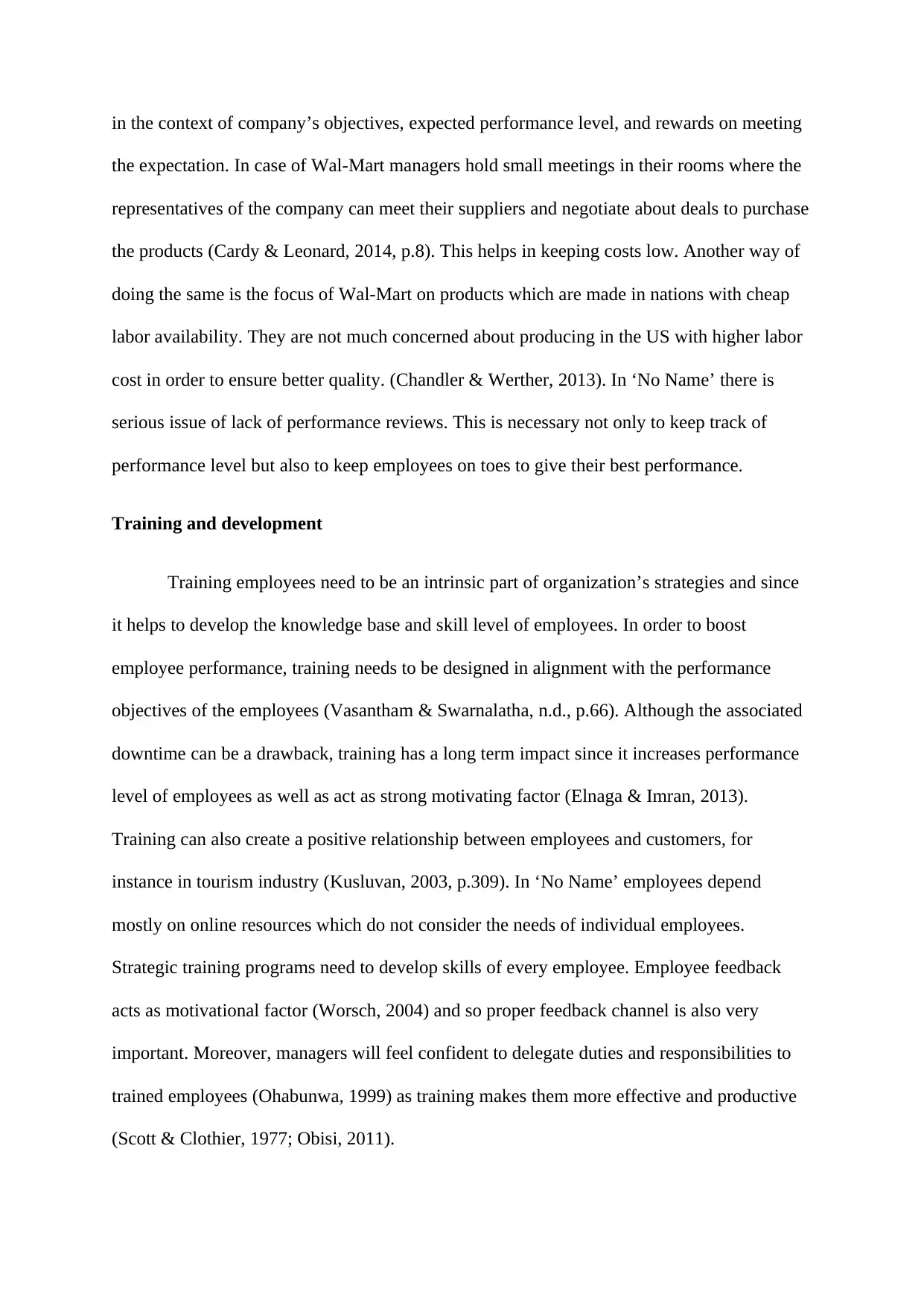
in the context of company’s objectives, expected performance level, and rewards on meeting
the expectation. In case of Wal-Mart managers hold small meetings in their rooms where the
representatives of the company can meet their suppliers and negotiate about deals to purchase
the products (Cardy & Leonard, 2014, p.8). This helps in keeping costs low. Another way of
doing the same is the focus of Wal-Mart on products which are made in nations with cheap
labor availability. They are not much concerned about producing in the US with higher labor
cost in order to ensure better quality. (Chandler & Werther, 2013). In ‘No Name’ there is
serious issue of lack of performance reviews. This is necessary not only to keep track of
performance level but also to keep employees on toes to give their best performance.
Training and development
Training employees need to be an intrinsic part of organization’s strategies and since
it helps to develop the knowledge base and skill level of employees. In order to boost
employee performance, training needs to be designed in alignment with the performance
objectives of the employees (Vasantham & Swarnalatha, n.d., p.66). Although the associated
downtime can be a drawback, training has a long term impact since it increases performance
level of employees as well as act as strong motivating factor (Elnaga & Imran, 2013).
Training can also create a positive relationship between employees and customers, for
instance in tourism industry (Kusluvan, 2003, p.309). In ‘No Name’ employees depend
mostly on online resources which do not consider the needs of individual employees.
Strategic training programs need to develop skills of every employee. Employee feedback
acts as motivational factor (Worsch, 2004) and so proper feedback channel is also very
important. Moreover, managers will feel confident to delegate duties and responsibilities to
trained employees (Ohabunwa, 1999) as training makes them more effective and productive
(Scott & Clothier, 1977; Obisi, 2011).
the expectation. In case of Wal-Mart managers hold small meetings in their rooms where the
representatives of the company can meet their suppliers and negotiate about deals to purchase
the products (Cardy & Leonard, 2014, p.8). This helps in keeping costs low. Another way of
doing the same is the focus of Wal-Mart on products which are made in nations with cheap
labor availability. They are not much concerned about producing in the US with higher labor
cost in order to ensure better quality. (Chandler & Werther, 2013). In ‘No Name’ there is
serious issue of lack of performance reviews. This is necessary not only to keep track of
performance level but also to keep employees on toes to give their best performance.
Training and development
Training employees need to be an intrinsic part of organization’s strategies and since
it helps to develop the knowledge base and skill level of employees. In order to boost
employee performance, training needs to be designed in alignment with the performance
objectives of the employees (Vasantham & Swarnalatha, n.d., p.66). Although the associated
downtime can be a drawback, training has a long term impact since it increases performance
level of employees as well as act as strong motivating factor (Elnaga & Imran, 2013).
Training can also create a positive relationship between employees and customers, for
instance in tourism industry (Kusluvan, 2003, p.309). In ‘No Name’ employees depend
mostly on online resources which do not consider the needs of individual employees.
Strategic training programs need to develop skills of every employee. Employee feedback
acts as motivational factor (Worsch, 2004) and so proper feedback channel is also very
important. Moreover, managers will feel confident to delegate duties and responsibilities to
trained employees (Ohabunwa, 1999) as training makes them more effective and productive
(Scott & Clothier, 1977; Obisi, 2011).
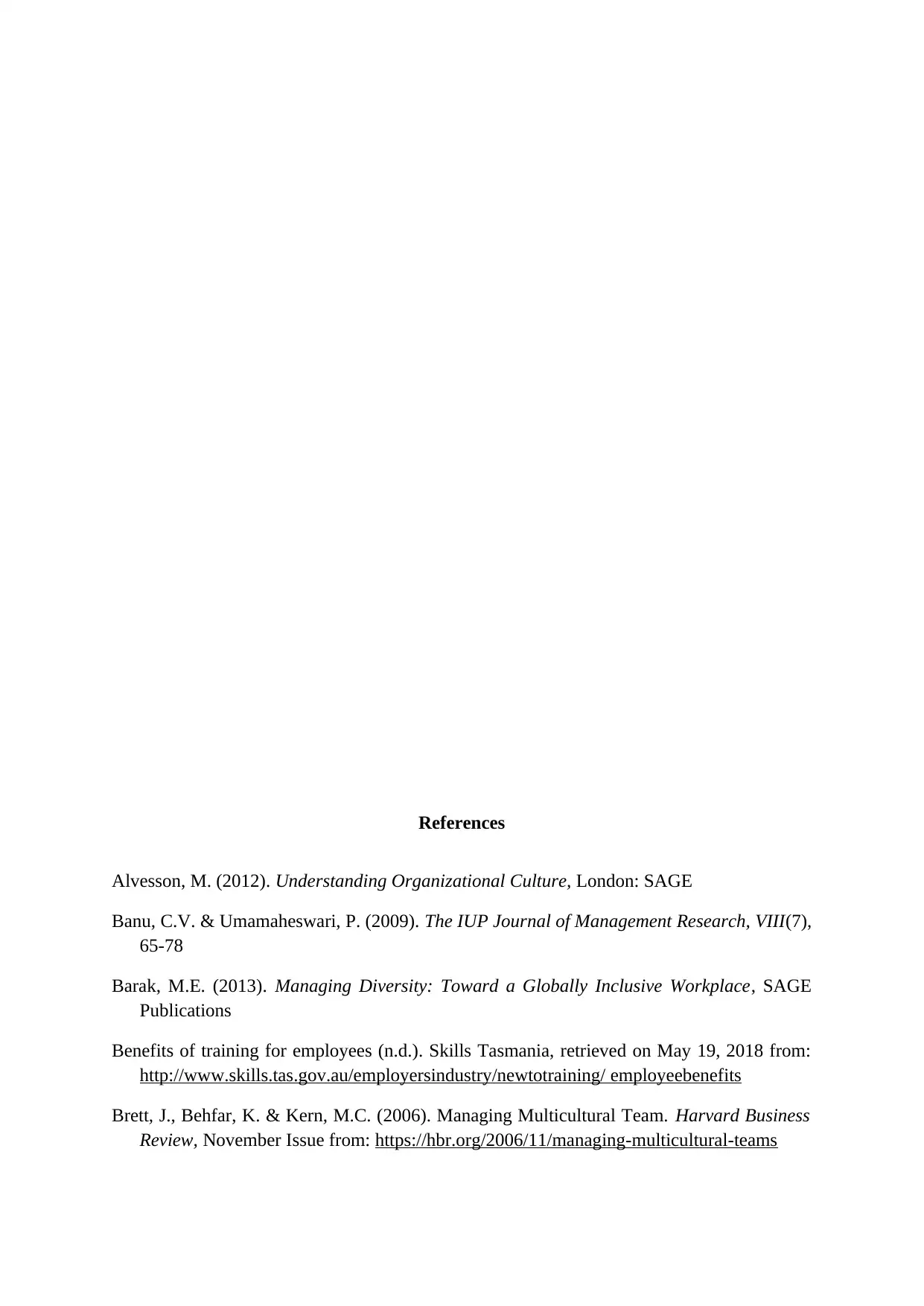
References
Alvesson, M. (2012). Understanding Organizational Culture, London: SAGE
Banu, C.V. & Umamaheswari, P. (2009). The IUP Journal of Management Research, VIII(7),
65-78
Barak, M.E. (2013). Managing Diversity: Toward a Globally Inclusive Workplace, SAGE
Publications
Benefits of training for employees (n.d.). Skills Tasmania, retrieved on May 19, 2018 from:
http://www.skills.tas.gov.au/employersindustry/newtotraining/ employeebenefits
Brett, J., Behfar, K. & Kern, M.C. (2006). Managing Multicultural Team. Harvard Business
Review, November Issue from: https://hbr.org/2006/11/managing-multicultural-teams
Alvesson, M. (2012). Understanding Organizational Culture, London: SAGE
Banu, C.V. & Umamaheswari, P. (2009). The IUP Journal of Management Research, VIII(7),
65-78
Barak, M.E. (2013). Managing Diversity: Toward a Globally Inclusive Workplace, SAGE
Publications
Benefits of training for employees (n.d.). Skills Tasmania, retrieved on May 19, 2018 from:
http://www.skills.tas.gov.au/employersindustry/newtotraining/ employeebenefits
Brett, J., Behfar, K. & Kern, M.C. (2006). Managing Multicultural Team. Harvard Business
Review, November Issue from: https://hbr.org/2006/11/managing-multicultural-teams
⊘ This is a preview!⊘
Do you want full access?
Subscribe today to unlock all pages.

Trusted by 1+ million students worldwide
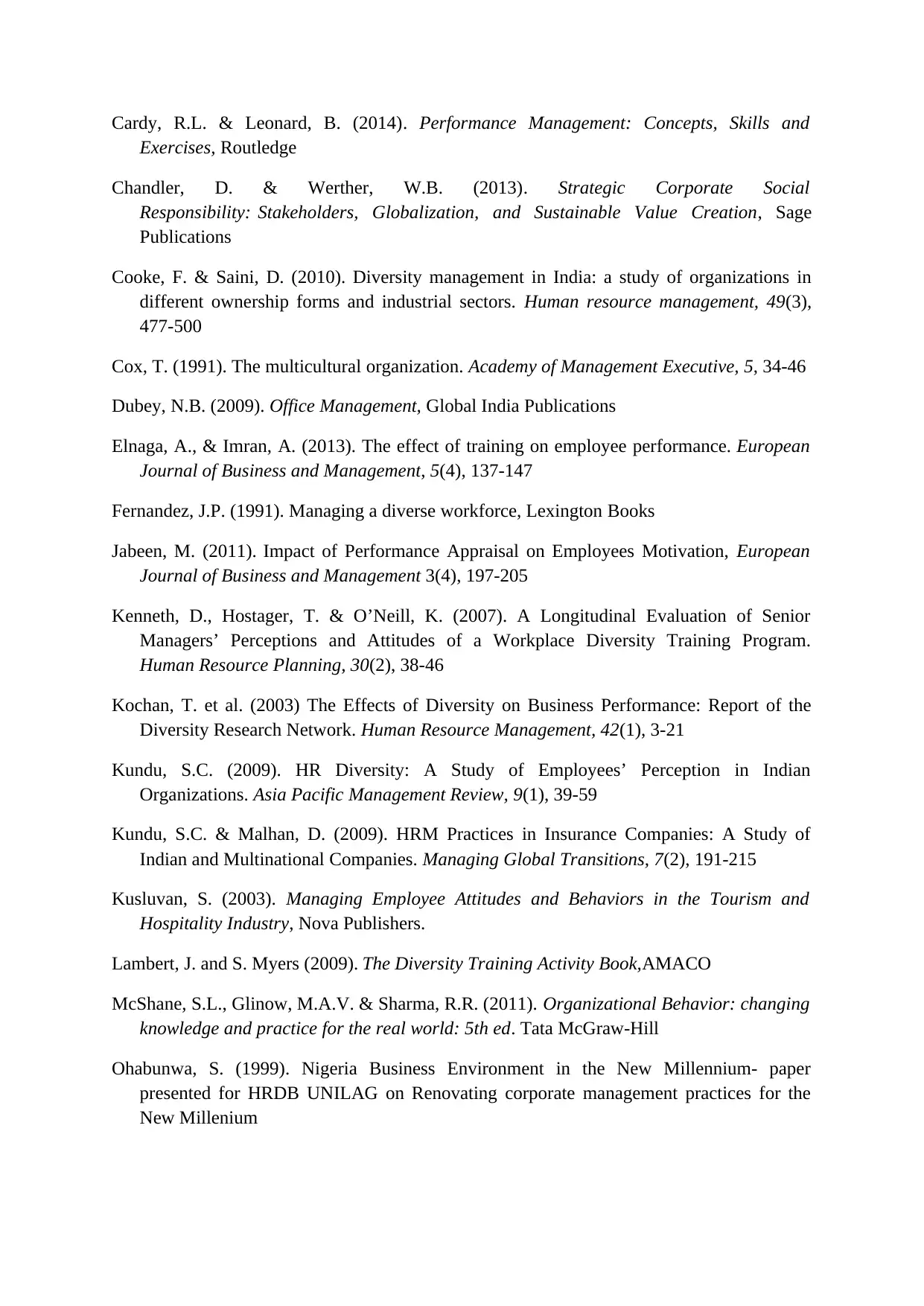
Cardy, R.L. & Leonard, B. (2014). Performance Management: Concepts, Skills and
Exercises, Routledge
Chandler, D. & Werther, W.B. (2013). Strategic Corporate Social
Responsibility: Stakeholders, Globalization, and Sustainable Value Creation, Sage
Publications
Cooke, F. & Saini, D. (2010). Diversity management in India: a study of organizations in
different ownership forms and industrial sectors. Human resource management, 49(3),
477-500
Cox, T. (1991). The multicultural organization. Academy of Management Executive, 5, 34-46
Dubey, N.B. (2009). Office Management, Global India Publications
Elnaga, A., & Imran, A. (2013). The effect of training on employee performance. European
Journal of Business and Management, 5(4), 137-147
Fernandez, J.P. (1991). Managing a diverse workforce, Lexington Books
Jabeen, M. (2011). Impact of Performance Appraisal on Employees Motivation, European
Journal of Business and Management 3(4), 197-205
Kenneth, D., Hostager, T. & O’Neill, K. (2007). A Longitudinal Evaluation of Senior
Managers’ Perceptions and Attitudes of a Workplace Diversity Training Program.
Human Resource Planning, 30(2), 38-46
Kochan, T. et al. (2003) The Effects of Diversity on Business Performance: Report of the
Diversity Research Network. Human Resource Management, 42(1), 3-21
Kundu, S.C. (2009). HR Diversity: A Study of Employees’ Perception in Indian
Organizations. Asia Pacific Management Review, 9(1), 39-59
Kundu, S.C. & Malhan, D. (2009). HRM Practices in Insurance Companies: A Study of
Indian and Multinational Companies. Managing Global Transitions, 7(2), 191-215
Kusluvan, S. (2003). Managing Employee Attitudes and Behaviors in the Tourism and
Hospitality Industry, Nova Publishers.
Lambert, J. and S. Myers (2009). The Diversity Training Activity Book,AMACO
McShane, S.L., Glinow, M.A.V. & Sharma, R.R. (2011). Organizational Behavior: changing
knowledge and practice for the real world: 5th ed. Tata McGraw-Hill
Ohabunwa, S. (1999). Nigeria Business Environment in the New Millennium- paper
presented for HRDB UNILAG on Renovating corporate management practices for the
New Millenium
Exercises, Routledge
Chandler, D. & Werther, W.B. (2013). Strategic Corporate Social
Responsibility: Stakeholders, Globalization, and Sustainable Value Creation, Sage
Publications
Cooke, F. & Saini, D. (2010). Diversity management in India: a study of organizations in
different ownership forms and industrial sectors. Human resource management, 49(3),
477-500
Cox, T. (1991). The multicultural organization. Academy of Management Executive, 5, 34-46
Dubey, N.B. (2009). Office Management, Global India Publications
Elnaga, A., & Imran, A. (2013). The effect of training on employee performance. European
Journal of Business and Management, 5(4), 137-147
Fernandez, J.P. (1991). Managing a diverse workforce, Lexington Books
Jabeen, M. (2011). Impact of Performance Appraisal on Employees Motivation, European
Journal of Business and Management 3(4), 197-205
Kenneth, D., Hostager, T. & O’Neill, K. (2007). A Longitudinal Evaluation of Senior
Managers’ Perceptions and Attitudes of a Workplace Diversity Training Program.
Human Resource Planning, 30(2), 38-46
Kochan, T. et al. (2003) The Effects of Diversity on Business Performance: Report of the
Diversity Research Network. Human Resource Management, 42(1), 3-21
Kundu, S.C. (2009). HR Diversity: A Study of Employees’ Perception in Indian
Organizations. Asia Pacific Management Review, 9(1), 39-59
Kundu, S.C. & Malhan, D. (2009). HRM Practices in Insurance Companies: A Study of
Indian and Multinational Companies. Managing Global Transitions, 7(2), 191-215
Kusluvan, S. (2003). Managing Employee Attitudes and Behaviors in the Tourism and
Hospitality Industry, Nova Publishers.
Lambert, J. and S. Myers (2009). The Diversity Training Activity Book,AMACO
McShane, S.L., Glinow, M.A.V. & Sharma, R.R. (2011). Organizational Behavior: changing
knowledge and practice for the real world: 5th ed. Tata McGraw-Hill
Ohabunwa, S. (1999). Nigeria Business Environment in the New Millennium- paper
presented for HRDB UNILAG on Renovating corporate management practices for the
New Millenium
Paraphrase This Document
Need a fresh take? Get an instant paraphrase of this document with our AI Paraphraser
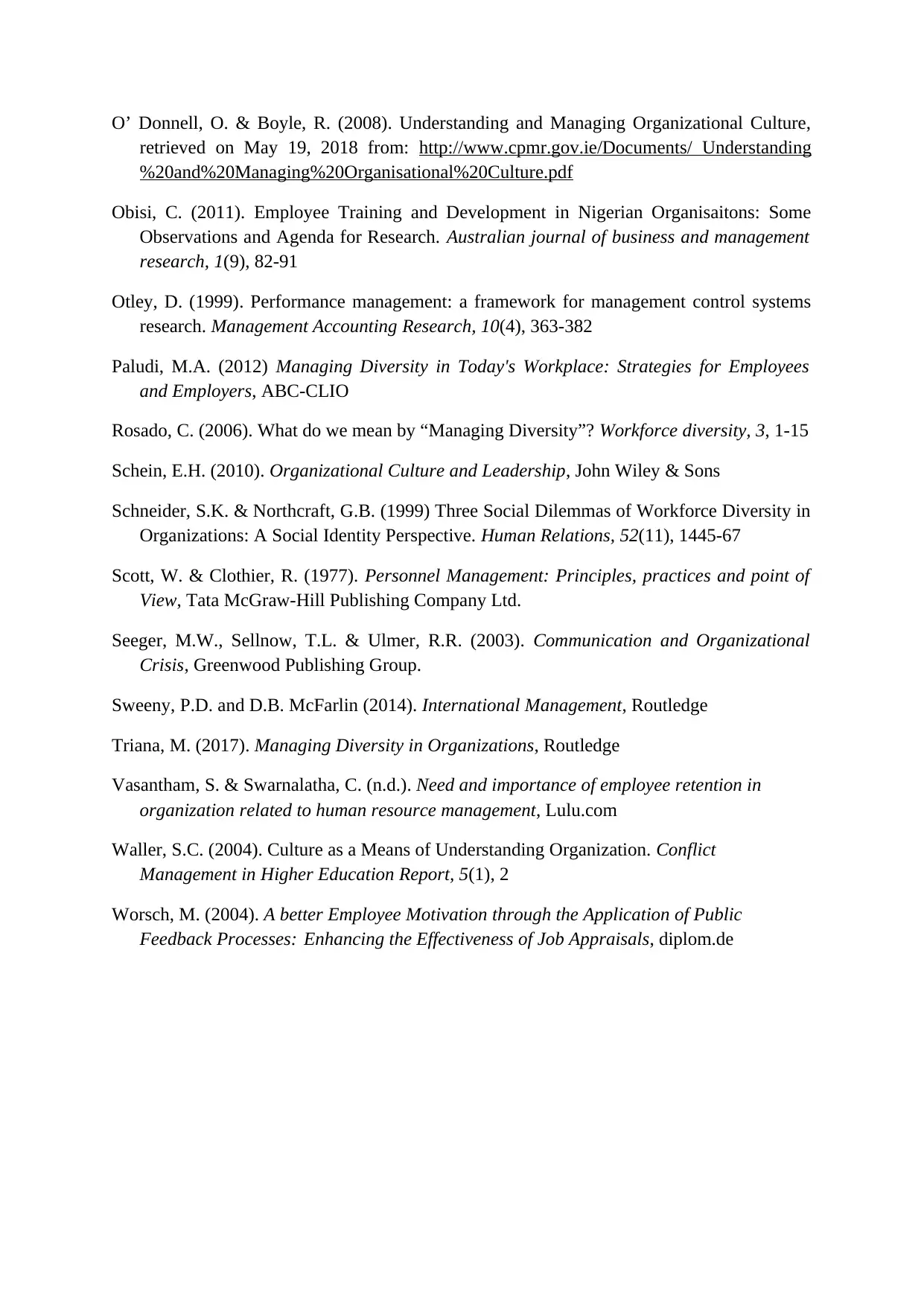
O’ Donnell, O. & Boyle, R. (2008). Understanding and Managing Organizational Culture,
retrieved on May 19, 2018 from: http://www.cpmr.gov.ie/Documents/ Understanding
%20and%20Managing%20Organisational%20Culture.pdf
Obisi, C. (2011). Employee Training and Development in Nigerian Organisaitons: Some
Observations and Agenda for Research. Australian journal of business and management
research, 1(9), 82-91
Otley, D. (1999). Performance management: a framework for management control systems
research. Management Accounting Research, 10(4), 363-382
Paludi, M.A. (2012) Managing Diversity in Today's Workplace: Strategies for Employees
and Employers, ABC-CLIO
Rosado, C. (2006). What do we mean by “Managing Diversity”? Workforce diversity, 3, 1-15
Schein, E.H. (2010). Organizational Culture and Leadership, John Wiley & Sons
Schneider, S.K. & Northcraft, G.B. (1999) Three Social Dilemmas of Workforce Diversity in
Organizations: A Social Identity Perspective. Human Relations, 52(11), 1445-67
Scott, W. & Clothier, R. (1977). Personnel Management: Principles, practices and point of
View, Tata McGraw-Hill Publishing Company Ltd.
Seeger, M.W., Sellnow, T.L. & Ulmer, R.R. (2003). Communication and Organizational
Crisis, Greenwood Publishing Group.
Sweeny, P.D. and D.B. McFarlin (2014). International Management, Routledge
Triana, M. (2017). Managing Diversity in Organizations, Routledge
Vasantham, S. & Swarnalatha, C. (n.d.). Need and importance of employee retention in
organization related to human resource management, Lulu.com
Waller, S.C. (2004). Culture as a Means of Understanding Organization. Conflict
Management in Higher Education Report, 5(1), 2
Worsch, M. (2004). A better Employee Motivation through the Application of Public
Feedback Processes: Enhancing the Effectiveness of Job Appraisals, diplom.de
retrieved on May 19, 2018 from: http://www.cpmr.gov.ie/Documents/ Understanding
%20and%20Managing%20Organisational%20Culture.pdf
Obisi, C. (2011). Employee Training and Development in Nigerian Organisaitons: Some
Observations and Agenda for Research. Australian journal of business and management
research, 1(9), 82-91
Otley, D. (1999). Performance management: a framework for management control systems
research. Management Accounting Research, 10(4), 363-382
Paludi, M.A. (2012) Managing Diversity in Today's Workplace: Strategies for Employees
and Employers, ABC-CLIO
Rosado, C. (2006). What do we mean by “Managing Diversity”? Workforce diversity, 3, 1-15
Schein, E.H. (2010). Organizational Culture and Leadership, John Wiley & Sons
Schneider, S.K. & Northcraft, G.B. (1999) Three Social Dilemmas of Workforce Diversity in
Organizations: A Social Identity Perspective. Human Relations, 52(11), 1445-67
Scott, W. & Clothier, R. (1977). Personnel Management: Principles, practices and point of
View, Tata McGraw-Hill Publishing Company Ltd.
Seeger, M.W., Sellnow, T.L. & Ulmer, R.R. (2003). Communication and Organizational
Crisis, Greenwood Publishing Group.
Sweeny, P.D. and D.B. McFarlin (2014). International Management, Routledge
Triana, M. (2017). Managing Diversity in Organizations, Routledge
Vasantham, S. & Swarnalatha, C. (n.d.). Need and importance of employee retention in
organization related to human resource management, Lulu.com
Waller, S.C. (2004). Culture as a Means of Understanding Organization. Conflict
Management in Higher Education Report, 5(1), 2
Worsch, M. (2004). A better Employee Motivation through the Application of Public
Feedback Processes: Enhancing the Effectiveness of Job Appraisals, diplom.de

⊘ This is a preview!⊘
Do you want full access?
Subscribe today to unlock all pages.

Trusted by 1+ million students worldwide
1 out of 9
Related Documents
Your All-in-One AI-Powered Toolkit for Academic Success.
+13062052269
info@desklib.com
Available 24*7 on WhatsApp / Email
![[object Object]](/_next/static/media/star-bottom.7253800d.svg)
Unlock your academic potential
Copyright © 2020–2025 A2Z Services. All Rights Reserved. Developed and managed by ZUCOL.





